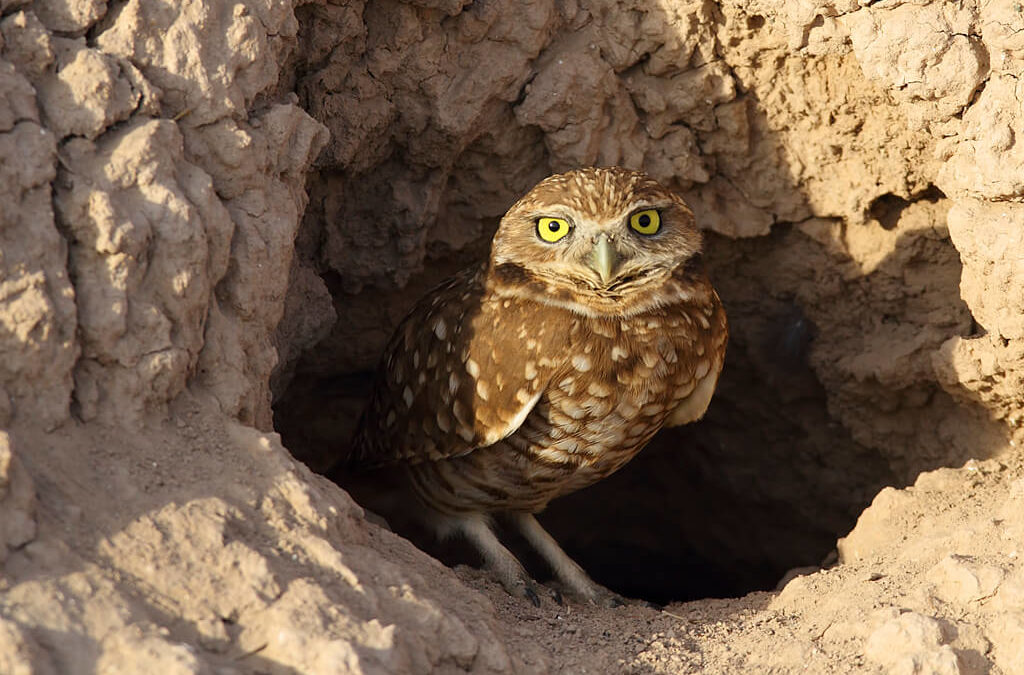
When we think of owls, we tend to think of them as gazing down upon us wisely from where they live up in the trees. It’s an accurate depiction—after all, most owls are tree-dwellers or, in the case of barn owls, they live in the eaves of manmade structures.
Either way, we know that owls live on high.
However, there is a species of owl that makes its home not up above, but down below, as in below the surface.
Owls That Live in the Ground
Called the burrowing owl (scientific name: Athene cunicularia), or less commonly “ground owls,” burrowing owls are diurnal birds that live underground, nesting and roosting in burrows. The burrowing owl nest of choice are the tunnels left behind by prairie dogs, but with those burrows growing scarce due to human development and prairie dog control programs, burrowing owls have been known to take up residence in golf courses, airports, vacant lots and other open areas. In their more plentiful days, cowboys called them “howdy owls” due to their habit of popping up out of their burrows to “greet” passersby.
While some owl species are fierce and imposing-looking, burrowing owls exist more at the cute end of the appearance spectrum. Long-legged yet compact, the burrowing owl size and tendency to nod as though saying hi make them a welcome sight in the wild. Along with their characteristic nodding, other burrowing owl habits include being night hunters (like most owls), and the burrowing owl diet consists of insects and small mammals that they often chase down and clutch in their talons, putting those long legs to good use. But do burrowing owls fly? Despite choosing to live in their namesake burrows, burrowing owls are not a ground-bound species—indeed they can fly and are especially adept at hovering over their prey.
Burrowing Owl Conservation
The desert, rangelands and dry grasslands of Nevada are excellent burrowing owl habitat, and their numbers have indeed been plentiful here. Part of that is due to the fact that the western burrowing owls are protected under the international Migratory Bird Treaty Act, making it illegal to “pursue, hunt, shoot, wound, kill, trap, capture, or collect” them without permission.
Despite such protection, populations have waned so much in some areas that the burrowing owl conservation status is considered to be endangered or threatened in some regions, according to the National Audubon Society.
The greatest threat to burrowing owls today: humans. Loss of burrowing owl range areas and habitat due to human development is considered the primary reason behind the depletion of this species’ population, and there are indirect causes to their failure to thrive as well. Prairie dog and ground squirrel control programs have limited the amount of roosts available to the owls (the burrowing owl does not build its own nests, after all) and owing to the amount of time they spend on the ground, they have fallen victim to what is known as “accidental mortality,” ie being hit by cars. As well, climate change is a matter of no small concern for this species, with increasing temperatures and more extreme fire seasons posing threats to their long-term prospects.
However, all is not bad news in the realm of burrowing owl conservation. They have proven to be a species that is willing and able to adapt to manmade burrows, and Nevada biological consulting companies such as Bio-Logical are experts in burrowing owl conservation. Their team of specialists utilizes measures such as surveys, buffer zones, passive relocation and construction of artificial burrows to help burrowing owls not only survive, but also thrive alongside human development.





Recent Comments